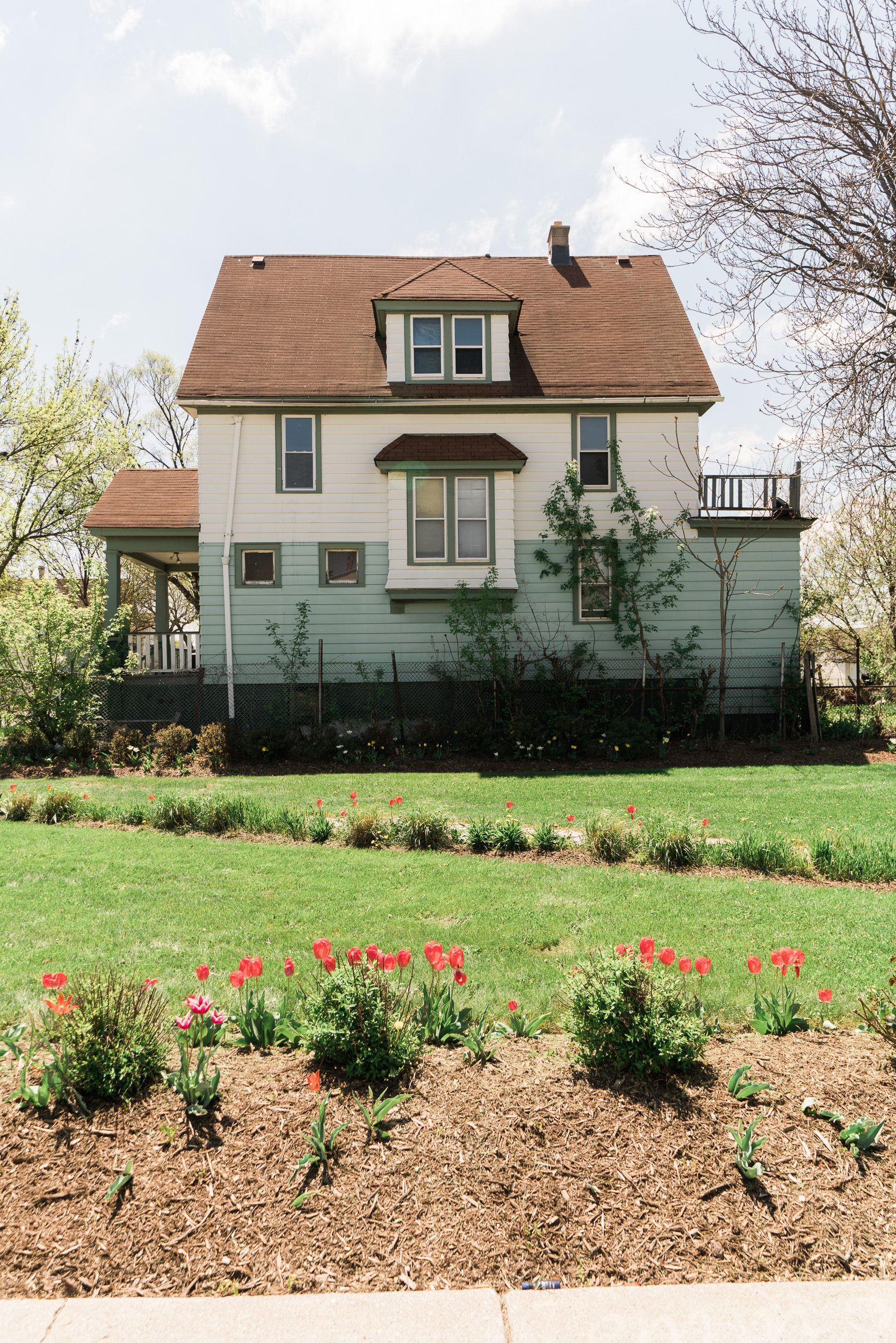
An isolated building in Chicago that had no neighboring structures. Photo by David Schalliol
Walk down Fayette Street in Baltimore’s distressed Franklin Square neighborhood, Warren Street on Detroit’s East Side, or North Market Street in The Ville in St. Louis, and vacancy—vacant houses, vacant storefronts, and vacant lots—is pervasive. The landscape is a landscape of vacancy. Rather than a few vacant houses scattered between those in which people live, people live interspersed between the vacant lots and vacant houses.
Little more than a mile north of The Ville, one comes to Penrose and Baden, two neighborhoods that for the most part look solid, with streets lined by brick houses that are set behind neatly trimmed lawns. Yet both neighborhoods are still struggling with the aftermath of the foreclosure crisis and middle-class flight, and increasing numbers of boarded-up vacant houses have started to pop up on even the best blocks.
These are the faces of the two vacancy crises in the United States.
At one level, they are similar. Vacant properties, when they are no longer being actively marketed and maintained, begin to destroy a neighborhood’s fabric. They diminish nearby property values; increase the risk of crime, fire, and public health problems; and generally undermine residents’ faith in their neighborhood and its future. Although the word “blight” is often overused or misused in describing urban conditions, it is certainly aptly used when applied to derelict, abandoned vacant structures and lots.
In other respects, though, these two crises are different, with significant implications for community development practitioners. Strategies that may work in dealing with one may not work with the other.
Hypervacancy in Disinvested Areas
As I wrote The Empty House Next Door, a recent Lincoln Institute of Land Policy publication on vacant properties, I realized that in many neighborhoods, abandonment and the vacant houses and vacant lots that result had become more than a problem; vacancy was the dominant feature of their landscape. I came up with the term “hypervacancy” to refer to that point. When the vacancy rate reported by the U.S. Census Bureau goes over 20 percent, we are likely to be looking at hypervacancy.
Let’s take an extreme but not unique example, census tract 5141 on the East Side of Detroit, an area that contains 2,700 separate property parcels. In 2013, when the Motor City Mapping project surveyed the area, it found 1,300 vacant lots. Of the remaining 1,400 structures, nearly 500 were vacant and abandoned. Two of every three parcels in this census tract were either a vacant lot or a vacant building.
Hypervacant areas are usually high-poverty areas, and usually areas that have been losing population. Census tract 5141 is no exception. According to the most recent census data, 59 percent of the residents (and 74 percent of the children) of the area fall below the poverty level, and 42 percent report themselves as unemployed. The population of the census tract today is about 3,000, compared to over 11,000 in 1970.
Although poverty and unemployment, as well as population loss, were major problems in older industrial cities well before the 1990s, up to that point hypervacancy was relatively rare, and in most cities it was concentrated in a small number of particularly hard-hit areas. This reflects the fact that up to around 1990, household sizes were also going down, so that the number of occupied housing units did not decline as fast as the population did.
Since then, however, hypervacancy has grown rapidly. In Baltimore in 1990 roughly 1 in 13 census tracts (7.5 percent) citywide was hypervacant. That hypervacancy gradually spread outward, engulfing most of East and West Baltimore. By 2010, the number of hypervacant tracts had quadrupled, to nearly 30 percent of all tracts.
Baltimore is far from being the hardest-hit city. Half the census tracts in Cleveland and nearly half in St. Louis are suffering from hypervacancy.
Hypervacancy basically means the housing market has ground to a halt, or nearly so. In Detroit’s census tract 5141, only two houses sold in 2015 and two more in 2016. Those houses sold for an average of a little over $10,000 each. Not a single home-purchase mortgage was made in that census tract from 2007 through the end of 2016.
In hypervacant areas, as houses become empty, they often don’t sell at all. The few that do—the ones in relatively good condition—are bought not by owner-occupants, but by investors. Rarely, though, by responsible landlords, but typically by the investors I’ve called “milkers”—people who invest little or nothing in the properties, hold them for only a few years, and then walk away. After all, if you can buy a property for $10,000, and rent it out for $600 a month, no questions asked, provide little or no maintenance, and not pay property taxes, at the end of three years you’ve doubled your investment. At that point, you don’t even care if the county takes it through tax foreclosure.
Vacant lots follow in the wake of vacant properties. If a property sits empty long enough, sooner or later it is demolished. Every one of those vacant lots in tract 5141 probably once had a house or other building on it. Cities like Detroit, Baltimore, and St. Louis have been demolishing vacant properties steadily since the 1950s, and many have picked up the pace in recent years. As Detroit’s Mayor Mike Duggan took office early this year for his second term, he bragged that during his first term, the city had knocked down almost 14,000 abandoned houses. Even before he was elected, though, Detroit already had over 100,000 vacant lots.
Rising Vacancies in Middle Neighborhoods at Risk
One of the most daunting but little-discussed challenges facing many cities, particularly the struggling cities of the Rust Belt, is the decline of many so-called “middle neighborhoods,” areas that until recently were functioning working-class and middle-class neighborhoods, the modest but solid communities that were traditionally the heart of the American city. Hundreds of these neighborhoods in cities like Detroit, St. Louis, or Baltimore have declined badly in recent years, buffeted by something close to a perfect storm.
Many of these neighborhoods have been under pressure for decades, as demographic changes—the decline in the number of child-rearing families in general, and married couples raising children in particular—and economic changes, such as the loss of the union factory jobs that sustained a large part of the urban working class, have taken a toll, as has the aging of their housing stock.
Over the past decade, though, more and more neighborhoods, including many that remained healthy communities through the 1990s, have found themselves in a state of crisis, triggered by the aftereffects of rampant subprime lending, the resulting foreclosure crisis, and accelerated out-migration of mostly African-American middle-class families. Many of these neighborhoods have never recovered from the beating they took between 2006 and 2010.
All of these factors have led to a loss of demand for middle neighborhoods that don’t have unique locations or architectural quality. The young millennials moving to the cities tend to be largely uninterested in these areas, and the married child-rearing couples that once populated them have become fewer and farther in between.
One byproduct of these neighborhoods’ decline is the increase in the number of vacant, abandoned properties. While the fabric of these neighborhoods is still fundamentally intact and most houses are well-maintained, vacant houses—a rarity 10 or 15 years ago—have become almost commonplace. As cities begin to demolish these houses, growing numbers of vacant lots are added to the mix. The STL Vacancy Portal, a vacant property database created by the St. Louis Vacancy Collaborative, counted 712 vacant buildings and vacant lots in Penrose and 554 in Baden. All of this is symptomatic of a decline that can also be seen in increasing rates of absentee ownership and poverty. Middle neighborhoods are a long way from hypervacancy; vacancies do not dominate the landscape, but they’ve become a visible part of it.
Researchers have confirmed what many residents of these neighborhoods intuitively know—it’s the first boarded house on the block that does most of the damage. Houses are still selling in Penrose and Baden, although for shamefully low prices. Most of the buyers these days, though, are investors rather than the homeowners who traditionally made up the majority of families in these neighborhoods. While they may not be necessarily the predatory investors found in the hypervacancy areas, few are likely to have a long-term commitment either to their properties or to the neighborhood.
Confronting the Two Crises
Looking at these two pictures, a couple of key differences immediately become apparent. First is the quantity of vacant properties. Typically in struggling middle neighborhoods the number of vacant properties, although rising, is still relatively small. Baltimore found that in the 88 small areas it designated as “Strategic Code Enforcement Neighborhoods,” a rough counterpart for middle neighborhoods, 32 contained fewer than 10 vacant, abandoned houses, and only 8 had over 50. By comparison, in Detroit’s tract 5141 alone, the Motor City Mapping team found nearly 1,800 vacant houses and lots.
Second is the level of market demand. While market demand is weak and uneven in struggling middle neighborhoods, it still exists. Indeed, as some cities and CDCs have found, many of these neighborhoods still appeal to moderate- or middle-income homebuyers, particularly if they can find houses in move-in condition. Similarly, such areas may draw some responsible landlords who are willing to invest in their properties.
Both homebuyers and responsible landlords are in short supply in hypervacant neighborhoods, where housing markets are all but nonexistent. While heavily subsidized projects, particularly if on a large enough scale, may draw some homebuyers or create pockets of new affordable rental housing, they generate few positive spillovers in the rest of the neighborhood, while the limited subsidy resources available mean that they are likely to touch only a handful of the area’s vacant properties, leaving the great majority to go on blighting their surroundings. Without steady market demand, one can only do so much, and that is far from enough.
Those few hypervacant areas that are adjacent to a strong neighborhood or a powerful anchor, such as a major medical center, may be an exception. Their location can sometimes create potential demand that can be unlocked by a concerted CDC or city strategy. In Baltimore, the city’s strategy to get vacant houses reused was particularly effective in some of those neighborhoods. In the small Greenmount West neighborhood, just north of downtown Baltimore and a short walk from Penn Station, the city’s efforts helped reduce the number of vacant, abandoned houses from 172 to 72 between 2010 and 2016.
Leaving aside those relatively few exceptions, the painful reality of hypervacant neighborhoods is that, if by “reuse” we mean that a vacant house is rehabilitated and occupied, or a vacant lot has a new house or some other type of building constructed on it, most of the vacant houses and vacant lots in these areas will not be reused, at least not within the lifetimes of most of the people working in the city or the neighborhood’s CDC. Not all, but most.
This reality poses a huge challenge for thoughtful people working in those neighborhoods. To rehab a couple of houses every year or two or build a Low Income Tax Credit project every few years while letting the vast majority of vacant buildings and lots fester is not remotely a neighborhood strategy. As a result, neighborhood advocates have increasingly turned to alternative strategies, including demolition and uses for vacant land that do not involve “development’” in the conventional sense, such as greening.
Demolition is painful, particularly in neighborhoods where many empty buildings are still structurally sound, and often possess architectural or historical merit. Yet while being careful not to remove properties that do have real reuse potential, there may be no alternative for many of the overabundant vacant properties in these areas. As long as they remain standing but empty, they are not only a constant drain on public resources to secure and maintain, but continue to undermine the health, safety, and quality of life of the people who live around them. People get this. As Jim Rokakis, former Cuyahoga County treasurer and father of Ohio’s land banking statute, told me, “I’ve been to hundreds of demolitions, and not once has a neighbor come up to me to complain. But I’ve gotten a lot of thank yous.”
This is a hard call, because the act of demolishing a lot of properties in a neighborhood, although improving quality of life in the short run, may work against the neighborhood’s long-term prospects. Contrary to what some people believe—namely, that demolition in distressed neighborhoods is a way to “clear the ground” for future gentrification—the opposite is true. Gentrification almost never happens in an area where large-scale demolition has removed the traditional close-knit neighborhood physical fabric, particularly in cities like Detroit or Cleveland where demand is still modest and easily accommodated in a handful of well-preserved neighborhoods close to downtown or major universities. It would be unconscionable, though, to disregard the needs of today’s residents in the interests of a highly uncertain—in terms of both whether and when it might happen—possible future outcome.
Every time you demolish a building, you get a vacant lot. Neglected, and allowed to become a dumping ground, a vacant lot can also blight a block. But it seems to be easier to keep vacant lots from harming a neighborhood than vacant buildings. They are less expensive to keep clean, and above all, lots can be used in a variety of “green” ways that can make them neighborhood assets. They can become market gardens, mini-parks, tree farms, and much more. And where there isn’t enough resident energy to get a garden or mini-park going, cities might consider what the Pennsylvania Horticultural Society (PHS) came up with. They call it their LandCare program. They take a lot, put down sod, plant a small tree or two, and put up a simple split-rail fence. Once that happens—at a cost of about $1,000 to $1,500 per lot—with few exceptions, people respect the lot, and the cost of maintenance is modest. PHS maintains 7,000 vacant lots around the city of Philadelphia through the LandCare program.
One of the biggest obstacles to successful use of greening as a strategy to deal with vacant properties is psychological, not practical. Local officials, even in the most distressed cities, seem to have an extraordinarily hard time accepting the reality that vast numbers of vacant lots are going to be a more or less permanent part of the urban landscape. Instead of planning for long-term use as open space—and working with neighborhoods to that end—far too many cherish the fantasy that sooner or later a developer will come along and develop the lots for new houses, a shopping center, or an office park. As a result, they insist that green uses are only interim uses, and refuse to give CDCs and others more than one- or two-year leases on city-owned property, making it impossible for those CDCs to put serious money into their greening projects. Cities have tens of thousands of vacant lots, and their numbers are growing every day. They are not going away.
In the end, demolition, community gardens, programs like LandCare, and the like may not transform neighborhoods, but they make them safer, healthier, and more livable. And that is no small thing.
As we turn to the second crisis, that of the middle neighborhoods, the paramount challenge is reversing the growth in vacant properties before it becomes too late, and using the properties in ways that will help stabilize the neighborhood and slow—or halt—its decline. The big difference between a neighborhood where houses sell for $25,000 or $30,000 and one where they sell for $60,000 or $70,000 is that in the latter—as CDCs in Youngstown and Cleveland have shown—it is possible to rehabilitate a vacant house and sell it to a homebuyer with little or no public subsidy. Equally important, of course, is the fact that there are usually a fair number of families who are interested in buying homes in these neighborhoods.
As a result, a selective strategy that focuses mostly on housing rehabilitation and rebuilding stable homeownership—including helping existing homeowners keep their homes—can work in many middle neighborhoods. The most important thing, though, is to be able to keep rehab costs down, so that they do not exceed realistic sales prices for houses in move-in condition in the neighborhood. Such a strategy has to be more than simply about rehab. Homebuyers must be recruited and prepared for homeownership, and they need to be able to get mortgages. When the Youngstown Neighborhood Development Corporation realized that many of its prospective buyers were unable to get mortgages, it raised the funds to start making its own mortgages, and convinced a local bank to service the mortgages for a modest fee. Finally, neighborhood confidence, which in these neighborhoods is often vanishingly low, needs to be rebuilt. Seeing vacant houses restored to use and filled with young homeowners goes a long way, but is unlikely to be enough to overcome a decade or more of declining hopes and home equity.
Vacant properties devalue neighborhoods, and undermine residents’ quality of life and confidence in their community. They may not be the cause of a neighborhood’s problems, but whatever the underlying problems, the presence of vacant, abandoned properties is likely to make them worse. With the right strategies, as we’ve seen, they can be tackled, and progress made. Those strategies, though, must be sensitive to the characteristics of the community, and above all, the extent of vacancy, and the market conditions and potential of the area.




Comments